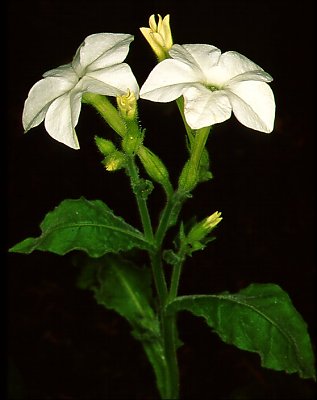
From Entheology: Nicotiana Rustica: Mapucho
Tobacco is one of the most important plants in the lives of all tribes of the northwest Amazon.
Mapacho is considered very sacred by Amazonian shamans and is employed alone (by tabaqueros) or in combination with other plants in shamanic practices. Some shamans drink the juice of tobacco leaves alone as a source of visions. Mapacho is used extensively in healing practices and is considered a medicine, not a health hazard, when used properly.
The mestizo ayahuasqueros of Perú mix tobacco juice with Ayahuasca, crushing the leaves and softening them with saliva, leaving the juice overnight in a hole cut into the trunk of the lupuna tree (Trichilia tocachcana), the presumably toxic sap of which drips into the tobacco juice. Amongst the western Tukanos of Colombia and Brazil, master medicine men make their students drink a gourdful of the juice to cause vomiting and eventual narcosis. The Jivaros of Ecuador drink the juice in initiations, visionary quests, war preparations, victory feasts and witchcraft; even women partake of the juice in wedding feasts and initiations
From Tobacco: A Cultural History of How an Exotic Plant Seduced Civilization by Iain Gately
Tobacco played a central role in the spiritual training of shamans. In the right doses, tobacco is a dangerously powerful drug and a fatal poison. Shamans used tobacco, often in conjunction with other narcotics, to achieve a state of near death, in the belief that "he who overcomes death by healing himself is capable of curing and revitalizing others". Shamans undergoing initiation training were required to take enough tobacco to bring them to the edge of the grave.
The spiritual journeys undertaken by initiate shamans were perceived as real quests, during the course of which the neophyte would encounter terrible hazards. The priest shaman of the Warao, for example, endured a series of perils similar to those set out in computer games. After clearing an abyss "filled with hungry jaguars, snapping alligators, and frenzied sharks, all eager to devour him" the tobacco intoxicated neophyte had to
pass places where demons armed with spears are waiting to kill him, where slippery spots threaten to unbalance, and where giant raptors claw him. Finally, he must pass through a hole in an enormous tree with rapidly opening and closing doors. These symplegades are the actual threshold between life and death. Jumping through the clashing doors, he beholds the bones of those who went before him but failed to clear the gateway. Not finding his own bones among them he returns from the other-world restored to new life.
A tobacco shaman used the weed in almost every aspect of his art. Tobacco smoke was employed as a diagnostic tool to examine sick patients, and formed a part of many ceremonies over which these doctor-priests officiated. Ritual smoke blowing, by which a shaman might bestow a blessing or protection against enemies both real and invisible, was intended to symbolize a transformation, in which the tobacco smoke represented a guiding spirit, and thus is reminiscent of Christian ritual, whereby wine and bread are transubstantiated by a priest into the body and blood of Christ himself. Shamans therefore were early proponents of passive smoking, which they believed to be a force for good for non-smokers...
Tobacco was drunk in sufficient quantities at shamanic initiation ceremonies to induce vomiting, paralysis and, occasionally, death. Even everyday tobacco drinkers attributed mystic powers to their brew. Hunters of the Mashco tribe drank to communicate with the game animals that they wished to kill. Hunters in some tribes would apply tobacco juice as eye drops in order to help them see in the dark. In several cases this privilege was extended to their hunting dogs...
Shamans used tobacco smoke for healing and blessing, and also as a form of food to nourish their guiding spirits. Shamans believed that they entered into a contract with the spirit world upon initiation, whereby they undertook to provide sustenance to the spirits in the form of tobacco, in return for receiving healing and other powers. Spirits that had taken up residence within the shaman's body were nourished by the tobacco he himself used, whereas those living in crystals or other sacred objects had smoke blown over them. For example, the shaman of the Campa tribe owned a sacred rock which he would smoke over and "feed" daily with tobacco juice.
The preferred implement for smoking tobacco was the cigar, which could be of prodigious size, especially those prepared by shamans, where examples of a metre or more in length are not uncommon. These were made from rolls of cured tobacco, often wrapped around a stick or the rib of a banana leaf. Some tribes developed special cigar supports, resembling giant tuning forks, which could be held in the hand, or whose sharp end could be stuck in the ground to support these monsters. Shamans’ cigars occasionally were sprinkled with carana granules which affected the vocal cords and masked the voice of the smoker, giving it a harsh, deep inflection which was considered appropriate for ritual discourse between mankind and the spiritual powers.